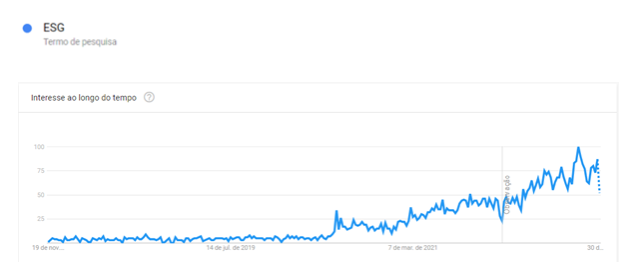Technology as an ally in managing the evolution of positive actions for business, the planet, and people
That the public interest in monitoring ESG agenda of economic agents in the public and private spheres has fostered important milestones in the transformation of the economy, towards conscious capitalism, there is no doubt. As data from Google Trends demonstrates, the volume of searches for the term has increased dramatically, having more than doubled between 2020 and 2022.

Although the pillars of environment and governance have gained more prominence in media, often leading the tone of discussions about the future of business and the planet, it is important to remember that it is the social vein that humanizes the purpose of any company, basing its commitment to the development of its community by generating a positive impact on people.
In general, large companies promote the social pillar of ESG for reasons such as:
- Keep the company competitive and sustainable in the long term.
- Promote a culture of employee engagement and satisfaction, which is reflected in the way we work and customer service.
- Be recognized as an employer brand.
- Add value to stakeholders, as diversity and inclusion encourage the development of innovative solutions, as well as collective respect.
- Ensure a safe and healthy work environment, protecting what matters most, which is life.
- Develop employees, contributing to professional satisfaction and increased performance, as well as enhancing results.
- Stimulate local development, strengthening the supplier network and, consequently, the sector.
- Create a fertile community environment, either by increasing gender equity, supporting small businesses, or reducing social inequality.
The fact is that the consolidation of best social practices also generates public endorsement for the brand’s reputation, since, with a strengthened community, the company is seen as a reference in what it does, captivating more employees, partners, and customers.
And technology is a great ally in monitoring the continuous evolution of these activities in the ecosystem in which companies operate, considering the intersection of specific actions for each stakeholder and the verification of the achievement of the goals that underlie their commitments.
Being able to manage and adopt good practices in the three ESG axes, reaching the level of efficiency in which sustainability plays a central role in the organization, is only possible with the use of robust solutions that help teams to continuously monitor their evolution in each dimension this agenda, converting KPIs into guides for business decision-making.
Check out 6 examples of social indicators commonly found in companies from different sectors:
- Diversity and inclusion policies
- Employee benefits
- Programs related to health and safety at work
- Support for training and professional education
- Management against discrimination and that evaluates the promotion of human rights
- Initiatives that strengthen the relationship with the community, customers, and suppliers, such as sponsorship of cultural activities, volunteer actions and promotion of entrepreneurship
The challenges of integrated ESG management:
As ESG initiatives take root in global organizational agendas, especially for publicly traded companies, overcoming the challenges of accountability and turning data into insights is essential to add effective value to organizational strategy. Thus, it is necessary:
- Identify which are the material topics and ESG indicators that best reflect the desired evolution in each of them;
- Recognize which areas of the organization are responsible for each of these topics, making them responsible for managing these indicators, with appropriate periodicity;
- Automate both the collection of information and the elaboration of complex calculations, to give managers greater power of analysis;
- Correlate the organization’s material topics with external information requests, such as the information demands required by different reporting programs, GRI and SASB, for example.
Understanding what should be measured and what needs to be improved is an activity that requires in-depth and up-to-date knowledge from the responsible team. In addition, the calculation of indicators requires confidence in the veracity of this information and subsequent production of reports, in accordance with the guidelines of the main reporting programs in the market.
Another key characteristic is agility. Which means, for sustainability to guide the decisions of the companies’ top management, there must be awareness of the company’s evolution in material matters on an ongoing basis. This, however, needs to be intrinsically linked to data transparency and accuracy, and therefore the need for external audits.
Climas, the benchmark software for ESG management
To help companies with the challenges of managing so many KPIs, describing them to reporting programs and evolving their sustainable strategies, WayCarbon has developed Climas, which is the leading ESG management solution in the Latin American market. The platform has more than 16 years of academic and marketing knowledge on topics such as sustainability and climate change.
Far beyond managing indicators, Climas is a platform that allows companies to structure their ESG management, permeating different areas and operational levels, leading to the management of action plans that lead them to advance, in a concrete way, in the different material themes, ensuring the organization visibility, control and information security.
The solution is easily integrated with other software through APIs. On the one hand, the integration automates the collection of data from different sources, such as ERPs and people management systems. On the other hand, it provides data extraction through tools such as PowerBI, providing flexibility for consolidating ESG information with financial or operational data, for example.
In addition to the traditional modules for managing environmental indicators, such as GHG, water and energy, Climas goes further with the possibility of creating customized dashboards to facilitate the monitoring of specific topics, such as those of the Social dimension, mentioned in the paragraphs above, adding their results in the integrated vision of the evolution of ESG management in the company.
With an intelligent curation of questions from the main reporting programs in the world, the tool makes recommendations that help and speed up the process of submitting responses. Another important benefit is that the calculations of greenhouse gas emissions are performed automatically by the platform, simplifying a highly complex process to be carried out via spreadsheets, for example.
Climas also allows the company to carry out a self-assessment and monitor the evolution over time in relation to the organization’s goals and material topics. Thus, it provides robustness to the sustainability area, which starts to be thought of in a broad and integrated way, making it strategic, since it generates valuable results, which help decision-making.
The benefits of using technology in ESG management
Technology is fundamental to guide the integration of material issues into the companies’ strategy and significantly contributes to better performance, not only in ESG indicators, in addition to being indispensable in solving complex problems in this area, on a large scale and in an integral way.
There are many benefits of using a well-structured technology in ESG management:
- Organization of information that needs to be measured and of the entire process from collection, through registration, to data consolidation, following the company’s organizational structure to ensure the deployment of global corporate goals in a coherent manner.
- Agility, as the system can guide performance assessments on material topics over the months, to anticipate the results that will constitute the sustainability reports, performing calculations automatically, notifying the respective persons in charge and presenting the questions of the programs of reporting, making recommendations that accelerate the answers to quantitative questions so that the company can dedicate more time to more complex qualitative answers.
- Security and accuracy of the reported information, through the traceability of evidence on the reported data and the possibility of providing the relevant mechanisms for carrying out audits.
- Visibility of results, in real time, broadly, comparatively and in panels for each type of data, with different representations, according to the themes and responsibilities of each employee, for effective decision-making.
- Transparency in the relationship with stakeholders, by bringing reliability to the data and significantly facilitating the preparation of responses for submission in reporting programs, which is the way in which organizations can systematically report to society regarding risks, impacts and sustainability management mechanisms.
- Efficient ESG management, resulting from more organization, agility, integration with external solutions, as well as the decentralization of attributions by the various areas and hierarchical levels involved.
Recent events have shown how technologies and digitization have been and continue to be essential for companies to quickly adapt to global changes and uncertainties, be they health, economic and geopolitical. Likewise, the use of robust ESG management tools is key to successfully transitioning to more sustainable value chains.
Click here to learn more about Climas and request a demo.







